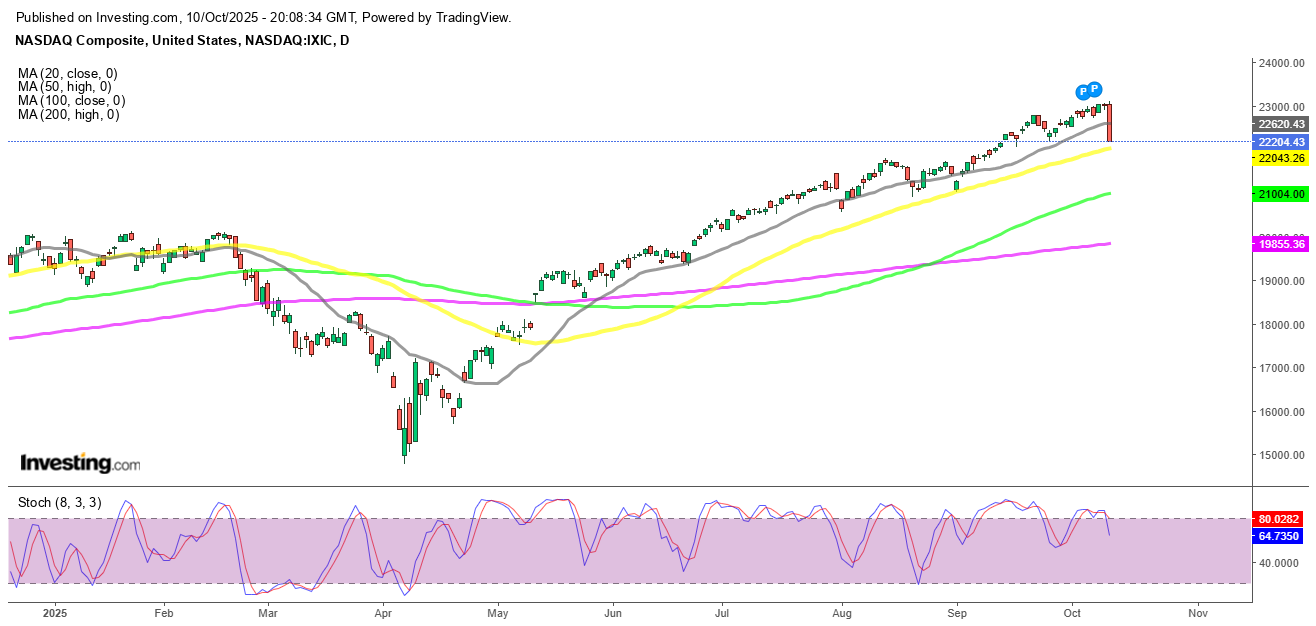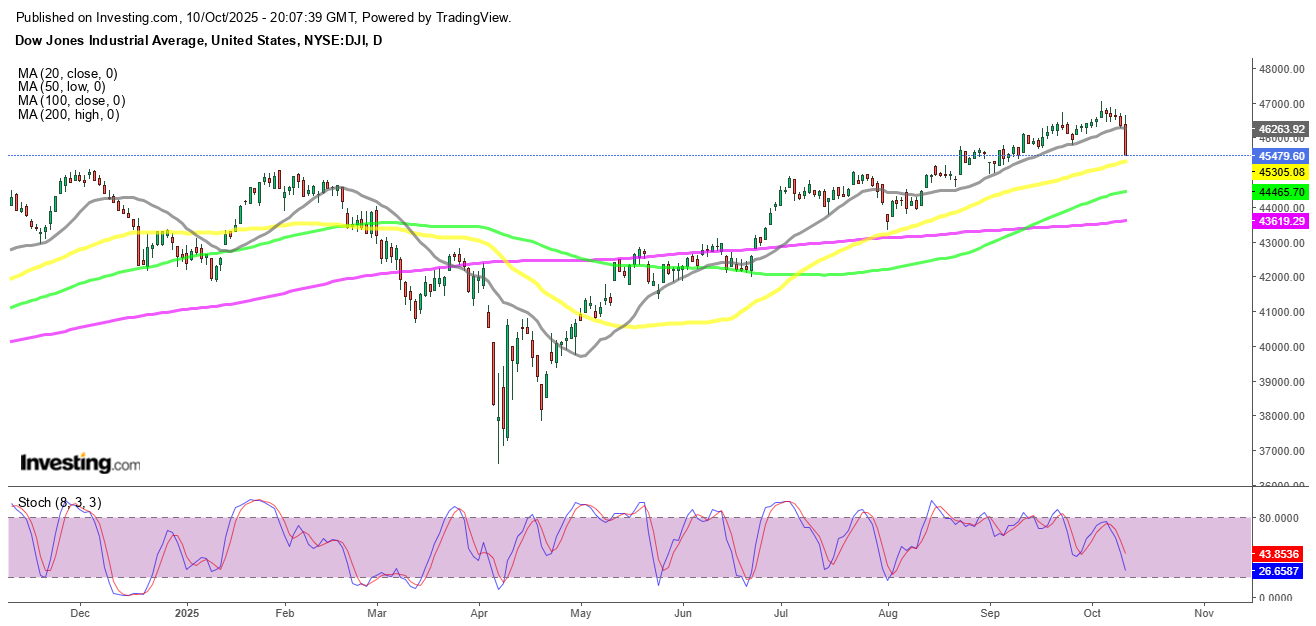Tech Stocks Sink Nasdaq, Dow Jones Drops as Tariff Fears Return
The Nasdaq and Dow Jones suffered steep declines on Friday, as renewed U.S.–China trade tensions triggered a wave of selling across the...

Quick overview
- The Nasdaq and Dow Jones experienced significant declines due to renewed U.S.–China trade tensions, with the Nasdaq dropping over 3.5%.
- Major tech stocks, particularly those with exposure to China, faced intense selling pressure, contributing to a broader market downturn.
- Investor sentiment turned defensive as bond yields rose, raising concerns about tighter financial conditions and upcoming inflation data.
- China's recent export controls on rare earth elements have sparked global alarm, leading to fears of disrupted supply chains and escalating trade tensions.
Live NAS100 Chart
The Nasdaq and Dow Jones suffered steep declines on Friday, as renewed U.S.–China trade tensions triggered a wave of selling across the technology sector and beyond. The selloff, sparked by tariff threats and China’s latest export controls, sent investors fleeing to safer assets, driving U.S. Treasury yields lower.
Nasdaq Leads the Slide as Big Tech Stumbles
The Nasdaq Composite plunged more than 3.5%, marking one of its sharpest single-day drops this quarter. Major tech names with heavy exposure to China, including Apple, came under intense selling pressure as fears of disrupted supply chains resurfaced. The sector’s weakness dragged the broader market sharply lower, erasing gains from earlier in the week.
The S&P 500 also sank 2.7%, reflecting widespread losses across nearly every sector. Selling accelerated in the afternoon session as traders reacted to headlines about escalating trade measures and a weaker outlook for global demand.
Dow Jones Suffers as Trade Concerns Ripple Across Markets
The Dow Jones Industrial Average also fell sharply, mirroring the selloff in growth and industrial stocks. Investors grew increasingly wary that rising tariffs could slow U.S. exports and hurt corporate margins. The combination of weaker global sentiment and cautious guidance from major firms added to the downward pressure.
Meanwhile, U.S. Treasury yields declined, signaling a flight to safety. The benchmark 10-year yield dropped 7.7 basis points to 4.07%, while the 2-year yield fell 5.4 basis points to 3.545%, reflecting expectations of slower economic growth ahead.
Major U.S. Stock Indices Slide Sharply to End the Week
U.S. equity markets closed significantly lower on Friday, capping a turbulent week marked by rising bond yields, geopolitical concerns, and renewed investor caution ahead of next week’s inflation data.
Friday’s Closing Performance
Nasdaq Composite:
- Ended the session at 22,200.58, tumbling −824.04 points (−3.5%) as heavy selling in technology and AI-related stocks dragged the index sharply lower.
S&P 500:
- Dropped −182.59 points (−2.7%) to close at 6,552.52, with all 11 major sectors finishing in the red.
Dow Jones Industrial Average:
- Declined −878.82 points (−1.9%), closing at 45,479.60, pressured by weakness in industrial and financial names.
Russell 2000:
- Fell −63.44 points (−2.6%) to 2,405.41, reflecting broad weakness in small-cap and cyclical shares.
Toronto TSX Composite:
- Closed at 29,888.63, down −381.35 points (−1.2%), as energy and mining stocks slid alongside U.S. markets.
Weekly Performance
- Nasdaq: Down 2.4% on the week, extending its three-week losing streak amid profit-taking in tech.
- S&P 500: Declined 2.5%, marking its worst weekly performance since early September.
- Dow Jones: Lost 2.7%, weighed by broad market risk-off sentiment.
- Russell 2000: Down 2.9%, continuing to underperform large caps.
- Toronto TSX Composite: Fell 1.9%, hurt by weaker commodity prices.
Market Context and Drivers
Investor sentiment turned defensive as bond yields climbed to multi-month highs, raising concerns about tighter financial conditions. Ongoing trade tensions and mixed corporate earnings added to the selling pressure. Traders also reduced exposure ahead of next week’s U.S. CPI and PPI reports, which could influence the Federal Reserve’s next policy move.
Trade War Fears Resurface
In a post on Truth Social, former President Donald Trump said the U.S. would need to raise tariffs on Chinese goods in response to Beijing’s new export restrictions on rare earth materials—critical elements used in semiconductors and renewable energy products. The announcement rattled markets that had been pricing in improved relations between the two nations.
China’s move to tighten export controls was viewed by analysts as a direct challenge to U.S. dominance in technology and defense manufacturing. This renewed uncertainty has left investors reassessing global trade dynamics just as the U.S. economy shows signs of cooling.
Summary: China’s Rare Earths Export Control Sparks Global Alarm
- China’s move: Beijing has issued letters to multiple nations signaling plans to impose export controls on rare earth elements and other key production inputs — even those not fully manufactured in China.
- Global reaction: The announcement has triggered widespread anger and concern, with governments warning that the move could severely disrupt global manufacturing and supply chains.
- Surprise factor: The decision came as a shock since U.S.–China relations had shown improvement over the last six months, making this sudden escalation unexpected.
- China’s strategy: Analysts interpret the move as part of a broader effort to consolidate control over the rare earth and magnet industries, effectively holding a monopoly that could make other nations dependent on Chinese exports.
- U.S. stance: Washington, which itself holds dominant positions in several other critical industries, has so far avoided weaponizing them — but that could change if tensions escalate further.
- Presidential response: President Trump has canceled a planned meeting with Xi Jinping at the APEC summit in South Korea, calling China’s move “hostile” — particularly given its timing during a Middle East peace breakthrough.
- Potential countermeasures: The U.S. is reportedly preparing a series of financial responses, including a sharp increase in tariffs on Chinese imports and additional trade restrictions now under review.
- Outlook: While acknowledging short-term economic pain, Trump and U.S. officials suggest the confrontation could strengthen America’s long-term position by reducing reliance on Chinese materials.
Conclusion: The sharp declines across Wall Street highlight growing investor unease over global trade and the fragility of tech-sector optimism. With bond yields falling and volatility rising, traders are bracing for further turbulence if U.S.–China relations continue to deteriorate. For now, sentiment remains cautious, with markets awaiting potential policy responses and guidance from Washington.
Nasdaq Live Chart
- Check out our free forex signals
- Follow the top economic events on FX Leaders economic calendar
- Trade better, discover more Forex Trading Strategies
- Open a FREE Trading Account





